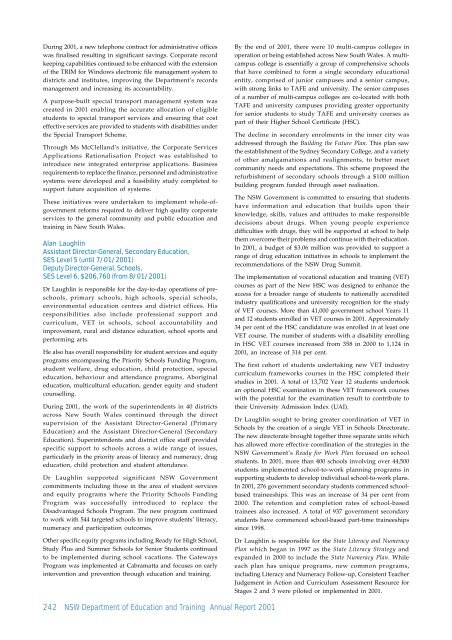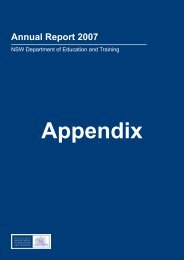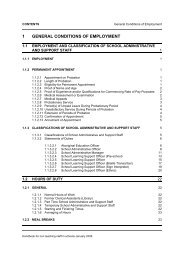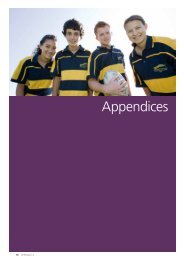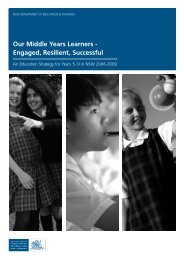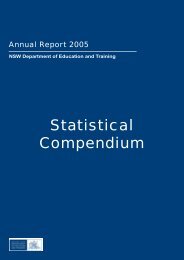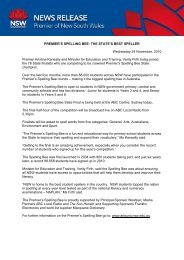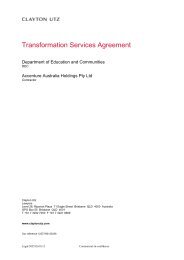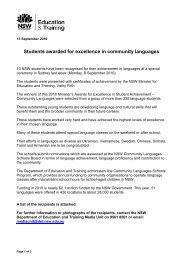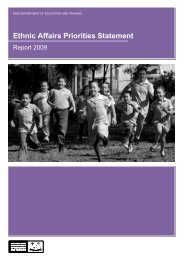APPENDICES - Department of Education and Communities - NSW ...
APPENDICES - Department of Education and Communities - NSW ...
APPENDICES - Department of Education and Communities - NSW ...
Create successful ePaper yourself
Turn your PDF publications into a flip-book with our unique Google optimized e-Paper software.
During 2001, a new telephone contract for administrative <strong>of</strong>ficeswas finalised resulting in significant savings. Corporate recordkeeping capabilities continued to be enhanced with the extension<strong>of</strong> the TRIM for Windows electronic file management system todistricts <strong>and</strong> institutes, improving the <strong>Department</strong>’s recordsmanagement <strong>and</strong> increasing its accountability.A purpose-built special transport management system wascreated in 2001 enabling the accurate allocation <strong>of</strong> eligiblestudents to special transport services <strong>and</strong> ensuring that costeffective services are provided to students with disabilities underthe Special Transport Scheme.Through Ms McClell<strong>and</strong>’s initiative, the Corporate ServicesApplications Rationalisation Project was established tointroduce new integrated enterprise applications. Businessrequirements to replace the finance, personnel <strong>and</strong> administrativesystems were developed <strong>and</strong> a feasibility study completed tosupport future acquisition <strong>of</strong> systems.These initiatives were undertaken to implement whole-<strong>of</strong>governmentreforms required to deliver high quality corporateservices to the general community <strong>and</strong> public education <strong>and</strong>training in New South Wales.Alan LaughlinAssistant Director-General, Secondary <strong>Education</strong>,SES Level 5 (until 7/01/2001)Deputy Director-General, Schools,SES Level 6, $206,760 (from 8/01/2001)Dr Laughlin is responsible for the day-to-day operations <strong>of</strong> preschools,primary schools, high schools, special schools,environmental education centres <strong>and</strong> district <strong>of</strong>fices. Hisresponsibilities also include pr<strong>of</strong>essional support <strong>and</strong>curriculum, VET in schools, school accountability <strong>and</strong>improvement, rural <strong>and</strong> distance education, school sports <strong>and</strong>performing arts.He also has overall responsibility for student services <strong>and</strong> equityprograms encompassing the Priority Schools Funding Program,student welfare, drug education, child protection, specialeducation, behaviour <strong>and</strong> attendance programs, Aboriginaleducation, multicultural education, gender equity <strong>and</strong> studentcounselling.During 2001, the work <strong>of</strong> the superintendents in 40 districtsacross New South Wales continued through the directsupervision <strong>of</strong> the Assistant Director-General (Primary<strong>Education</strong>) <strong>and</strong> the Assistant Director-General (Secondary<strong>Education</strong>). Superintendents <strong>and</strong> district <strong>of</strong>fice staff providedspecific support to schools across a wide range <strong>of</strong> issues,particularly in the priority areas <strong>of</strong> literacy <strong>and</strong> numeracy, drugeducation, child protection <strong>and</strong> student attendance.Dr Laughlin supported significant <strong>NSW</strong> Governmentcommitments including those in the area <strong>of</strong> student services<strong>and</strong> equity programs where the Priority Schools FundingProgram was successfully introduced to replace theDisadvantaged Schools Program. The new program continuedto work with 544 targeted schools to improve students’ literacy,numeracy <strong>and</strong> participation outcomes.Other specific equity programs including Ready for High School,Study Plus <strong>and</strong> Summer Schools for Senior Students continuedto be implemented during school vacations. The GatewaysProgram was implemented at Cabramatta <strong>and</strong> focuses on earlyintervention <strong>and</strong> prevention through education <strong>and</strong> training.By the end <strong>of</strong> 2001, there were 10 multi-campus colleges inoperation or being established across New South Wales. A multicampuscollege is essentially a group <strong>of</strong> comprehensive schoolsthat have combined to form a single secondary educationalentity, comprised <strong>of</strong> junior campuses <strong>and</strong> a senior campus,with strong links to TAFE <strong>and</strong> university. The senior campuses<strong>of</strong> a number <strong>of</strong> multi-campus colleges are co-located with bothTAFE <strong>and</strong> university campuses providing greater opportunityfor senior students to study TAFE <strong>and</strong> university courses aspart <strong>of</strong> their Higher School Certificate (HSC).The decline in secondary enrolments in the inner city wasaddressed through the Building the Future Plan. This plan sawthe establishment <strong>of</strong> the Sydney Secondary College, <strong>and</strong> a variety<strong>of</strong> other amalgamations <strong>and</strong> realignments, to better meetcommunity needs <strong>and</strong> expectations. This scheme proposed therefurbishment <strong>of</strong> secondary schools through a $100 millionbuilding program funded through asset realisation.The <strong>NSW</strong> Government is committed to ensuring that studentshave information <strong>and</strong> education that builds upon theirknowledge, skills, values <strong>and</strong> attitudes to make responsibledecisions about drugs. When young people experiencedifficulties with drugs, they will be supported at school to helpthem overcome their problems <strong>and</strong> continue with their education.In 2001, a budget <strong>of</strong> $3.06 million was provided to support arange <strong>of</strong> drug education initiatives in schools to implement therecommendations <strong>of</strong> the <strong>NSW</strong> Drug Summit.The implementation <strong>of</strong> vocational education <strong>and</strong> training (VET)courses as part <strong>of</strong> the New HSC was designed to enhance theaccess for a broader range <strong>of</strong> students to nationally accreditedindustry qualifications <strong>and</strong> university recognition for the study<strong>of</strong> VET courses. More than 41,000 government school Years 11<strong>and</strong> 12 students enrolled in VET courses in 2001. Approximately34 per cent <strong>of</strong> the HSC c<strong>and</strong>idature was enrolled in at least oneVET course. The number <strong>of</strong> students with a disability enrollingin HSC VET courses increased from 358 in 2000 to 1,124 in2001, an increase <strong>of</strong> 314 per cent.The first cohort <strong>of</strong> students undertaking new VET industrycurriculum frameworks courses in the HSC completed theirstudies in 2001. A total <strong>of</strong> 13,702 Year 12 students undertookan optional HSC examination in these VET framework courseswith the potential for the examination result to contribute totheir University Admission Index (UAI).Dr Laughlin sought to bring greater coordination <strong>of</strong> VET inSchools by the creation <strong>of</strong> a single VET in Schools Directorate.The new directorate brought together three separate units whichhas allowed more effective coordination <strong>of</strong> the strategies in the<strong>NSW</strong> Government’s Ready for Work Plan focused on schoolstudents. In 2001, more than 400 schools involving over 44,500students implemented school-to-work planning programs insupporting students to develop individual school-to-work plans.In 2001, 276 government secondary students commenced schoolbasedtraineeships. This was an increase <strong>of</strong> 34 per cent from2000. The retention <strong>and</strong> completion rates <strong>of</strong> school-basedtrainees also increased. A total <strong>of</strong> 937 government secondarystudents have commenced school-based part-time traineeshipssince 1998.Dr Laughlin is responsible for the State Literacy <strong>and</strong> NumeracyPlan which began in 1997 as the State Literacy Strategy <strong>and</strong>exp<strong>and</strong>ed in 2000 to include the State Numeracy Plan. Whileeach plan has unique programs, new common programs,including Literacy <strong>and</strong> Numeracy Follow-up, Consistent TeacherJudgement in Action <strong>and</strong> Curriculum Assessment Resource forStages 2 <strong>and</strong> 3 were piloted or implemented in 2001.242 <strong>NSW</strong> <strong>Department</strong> <strong>of</strong> <strong>Education</strong> <strong>and</strong> Training Annual Report 2001


